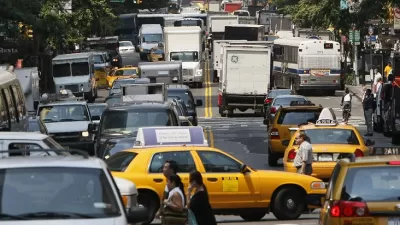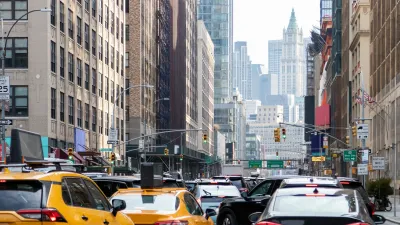The infamously car-centric city is weighing a proposed congestion pricing pilot program to reduce traffic and encourage public transit use.

L.A.’s notoriously traffic-choked freeways may soon not be so free anymore, reports Rachel Uranga for the Los Angeles Times. The Los Angeles County Metropolitan Transportation Authority (Metro), the region’s transit agency, is exploring a congestion pricing scheme for some of the city’s freeways and roads.
The plan so far lacks solid details, but Metro expects to release a full study of the potential program in the next few months. “The transit agency has zeroed in on three locations for a possible test program: a nearly 16-mile stretch of the 10 Freeway between downtown and Santa Monica, arterial streets and freeways around downtown and the canyon streets and freeways that connect the San Fernando Valley to the L.A. Basin.”
According to Uranga, “the plan promises cleaner air, smoother rides and more funds to the agency’s coffers in the future. Studies show it could reduce harmful air pollution and greenhouse gas emissions by pushing more commuters to use public transit, while making roads less hellish for those who pay to use them.”
Rather than having optional paid lanes, which already exist in the Los Angeles area, the congestion pricing proposal would apply to entire roadways. “The aim is to change commuter behavior with the charges while providing transit alternatives.” Those transit alternatives, which remain an inferior option in most parts of the city, will be key to getting commuters to switch modes.
On the other coast, New York City’s congestion pricing plan is inching forward. If implemented, it would be the first such plan in the country.
FULL STORY: The freeway was born in L.A. But it might not always be free to drive on

Study: Maui’s Plan to Convert Vacation Rentals to Long-Term Housing Could Cause Nearly $1 Billion Economic Loss
The plan would reduce visitor accommodation by 25,% resulting in 1,900 jobs lost.

North Texas Transit Leaders Tout Benefits of TOD for Growing Region
At a summit focused on transit-oriented development, policymakers discussed how North Texas’ expanded light rail system can serve as a tool for economic growth.

Why Should We Subsidize Public Transportation?
Many public transit agencies face financial stress due to rising costs, declining fare revenue, and declining subsidies. Transit advocates must provide a strong business case for increasing public transit funding.

How to Make US Trains Faster
Changes to boarding platforms and a switch to electric trains could improve U.S. passenger rail service without the added cost of high-speed rail.

Columbia’s Revitalized ‘Loop’ Is a Hub for Local Entrepreneurs
A focus on small businesses is helping a commercial corridor in Columbia, Missouri thrive.

Invasive Insect Threatens Minnesota’s Ash Forests
The Emerald Ash Borer is a rapidly spreading invasive pest threatening Minnesota’s ash trees, and homeowners are encouraged to plant diverse replacement species, avoid moving ash firewood, and monitor for signs of infestation.
Urban Design for Planners 1: Software Tools
This six-course series explores essential urban design concepts using open source software and equips planners with the tools they need to participate fully in the urban design process.
Planning for Universal Design
Learn the tools for implementing Universal Design in planning regulations.
Ascent Environmental
Borough of Carlisle
Institute for Housing and Urban Development Studies (IHS)
City of Grandview
Harvard GSD Executive Education
Toledo-Lucas County Plan Commissions
Salt Lake City
NYU Wagner Graduate School of Public Service




























